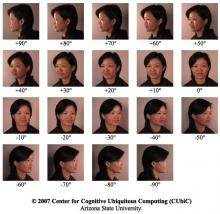
John A. Black, Jr
Position
Department
Contact
Publications
Projects
Prosopagnosia is a condition where individuals with otherwise normal vision are able to see faces, but cannot recognize faces. A major study in Germany (Kennerknecht 2006) reported that a congenital (inherited) form of prosopagnosia occurred at a rate of 2.5% in a sample…
To take notes in class, students with visual impairments must rapidly switch between writing their notes (a near-sight task) and viewing a board at the front of the classroom (a far-sight task). Current assistive technologies provide magnification for near-sight tasks,…
FacePix is a face image database created at the Center for Cognitive Ubiquitous Computing (CUbiC) at Arizona State University, and made available free of charge to the worldwide research community. In the first version of the FacePix database, called FacePix(30), there…
The inspiration for the iCare Reader was provided by focus groups of people who are blind, who asked CUbiC researchers for a reading machine that could be taken anywhere, and that was easier to use than the traditional flatbed scanning technology solutions that are…
The Remote Visual Explorer is designed to be an intuitive and natural extension of the human vision system. By integrating an eye-tracking monitor and a camera on a pant-tilt mechanism it allows an individual to explore a remote location. The user simply sits in front of…







